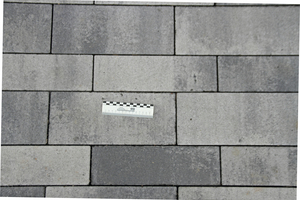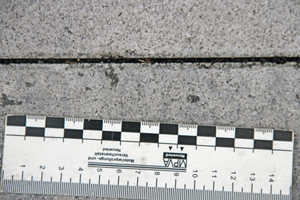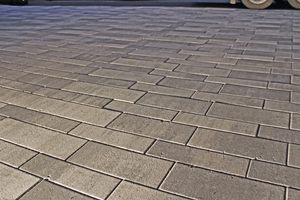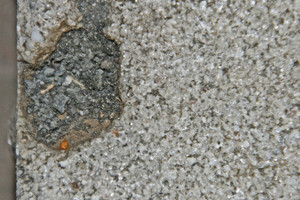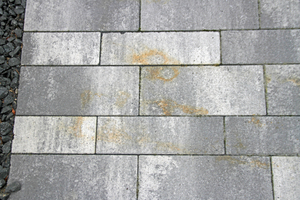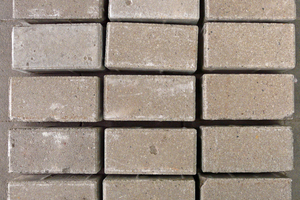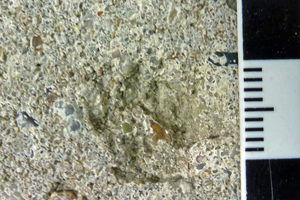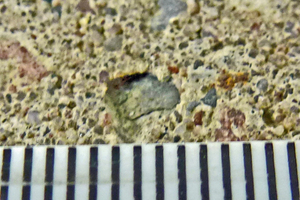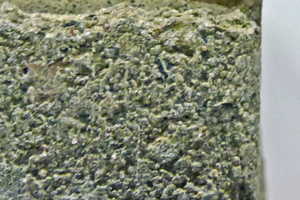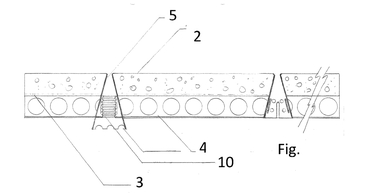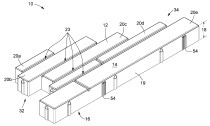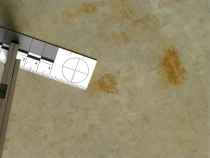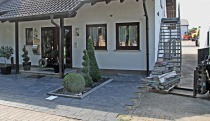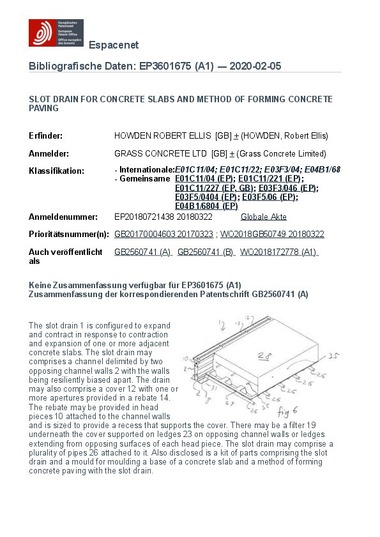Evaluation of blowholes in the surface of
concrete slabs or paving stones
In the context of legal disputes, the expert author was commissioned to answer questions concerning, among other things, the defectiveness and cause of shrinkage spots and rust discoloration in concrete slab or paving stone surfaces.
1 Initial question
1.1 Issue case 1 (concrete slabs)
The plaintiff had ordered approx. 133 m2 of concrete slabs at a net price of 20.50 euros via the construction trade. Shortly after the concrete slabs were laid by a landscaping contractor, the plaintiff complained about the appearance of cavities and holes as well as rust stains in the surface of the concrete slabs.
In the course of the legal dispute, the expert was commissioned to answer questions regarding the defectiveness and cause of the blowholes and the rust stains, among other things. In addition, the client complained that a muddy stone abrasion occurred when driving over the slab surface.
1.2 Issue case 2 (concrete paving stones)
The client had purchased concrete paving stones for the production of a paved surface and had the paving stones laid by a GaLa contractor. After laying, the plaintiff complained about the appearance of holes in the surface of the paving stones. As part of the order processing, the expert was commissioned to answer the following questions:
Are the surfaces of the concrete paving stones crumbling?
What is the cause of this damage?
2 Object descriptions
2.1 Object description case 1 (concrete slabs)
The slab pavement to be evaluated was a partially trafficked surface pavement in front of a private residence. During the visual inspection of the slabbed surface, neither the blowholes nor the rust stains were visually apparent.
Only on searching inspection as well as in the grazing light was a multitude of small to medium-sized blowholes/holes in the slab surfaces discernible.
In the center of some of the blowholes, remnants of weathering-resistant components were discernible.
No slushy stone abrasion was detectable during the site visit. The detailed inspection of the pavement further revealed that brownish discolorations were partially visible in the slab surface. On the basis of the visual appearance, it could almost be ruled out that these discolorations were caused by mobilizable iron contents from the facing or core concrete and were thus material-related.
2.1.1 On-site investigations and taking of samples
To answer the application questions, the slab pavement was opened in two locations. In these areas, the structure and drainage capability of the bedding was assessed, and samples were taken for laboratory testing. The following structure was found in the area of these surface openings:
A crushed sand 0/1 mm was used as joint material. The joints were almost completely filled;
Below the concrete slabs, a bedding chippings 2/5 mm was found in an installation thickness of approx. 3.5 cm. Thus, it can be stated that joint and bedding materials were not filter stable to each other. Nevertheless, immigration of the joint material into the bedding was not evident.
A simplified drainage test showed that the sub-bedding had an excellent drainage capacity.
2.2 Object description case 2 (concrete pavers)
No on-site visit was made by the expert. Instead, 16 paving stones were submitted by an expert client for laboratory testing and for the preparation of a material evaluation.
3 Results of laboratory tests
3.1 Laboratory testing of concrete paving blocks
Picture 5 shows the submitted paving stones. Detailed examination of the samples showed that some pavers had frayed stone edges and others had holes in the stone surface.
3.1.1 Assessment of conformity to standards
To evaluate the defectiveness of the concrete pavers at the time of testing, they were examined for their splitting tensile strength and length-related breaking load according to DIN EN 1338. The average tensile splitting strength was 4.8 N/mm2 and the smallest individual value was less than 3.6 N/mm2. When evaluating the determined splitting tensile strengths, it must be taken into account that the limit values of the relevant technical codes refer exclusively to the evaluation of new and not yet used concrete pavers. It should also be noted that there are no further known procedures for evaluating the properties of concrete paving blocks that have already been installed and used.
The evaluation of the material properties of building samples, both for concrete paving blocks and for other products such as natural or concrete paving blocks and asphalt surfaces, depends on their previous exposure in the object. In the case of building samples, for example, it must be taken into account that the products in the object have generally already been subjected to a large number of freeze-thaw cycles and mechanical stresses, which can lead to a reduction in the material quality even in the case of standard-compliant products. For this reason, negative material properties (frost and freeze-thaw resistance, abrasion, splitting tensile strength, but also efflorescence tendency) can be found in the examination of building samples depending on the installation and use, although the products were standard-compliant at the time of delivery.
Since it is not possible, or only possible to a very limited extent, to assess the standard conformity of building samples that have already been subjected to use at the time of delivery, the quality of the concrete pavers was roughly assessed according to Table B.1 of DIN EN 1338. According to this, four pavers were to be tested to determine the splitting tensile strength in Case II (externally inspected plant). Each of these four pavers had to meet the requirements for the characteristic splitting tensile strength T (≥ 3.6 N/mm²). In the event that only one of these four pavers fell below the splitting tensile strength, the number of specimens would have had to be increased to 16 and the following requirements would have had to be met:
The splitting tensile strength of a maximum of one paver may be less than 3.6 N/mm².
All split tensile strengths must be above 2.9 N/mm².
15 of the 16 concrete pavers tested in the laboratory showed tensile splitting strengths of more than 3.6 N/mm² and all tensile splitting strengths determined were above 2.9 N/mm². Thus, the tested pavers met the requirements of DIN EN 1338 mutatis mutandis (the pavers were building samples and not new and unbuilt pavers). Based on the test results, it could be assumed that the pavers also met the requirements of DIN EN 1338 at the time of delivery.
3.2 Estimation of the discoloration tendency of the concrete slabs
The following results were obtained when estimating the tendency of the concrete slabs to discolor:
Both the absorption behavior and the drying behavior of the concrete slabs were found to be as expected;
The water absorption of the facing concretes was found to be very low and thus at least as expected;
The compressive strength of the facing concretes was rated as high and thus at least as expected.
The tendency of the concrete slabs to discolor was to be rated as expected on the basis of the test results.
3.3 Abrasion of the concrete slabs
To assess the abrasion resistance, the concrete slabs were tested for abrasive wear according to Annex H of DIN EN 1339, and it was found that the concrete slabs exhibited only very low abrasion.
4 Damage assessment
4.1 Damage assessment of the concrete slabs (case 1)
Some of the concrete slabs showed blowholes or holes. Due to their small size and the appearance of the slab pavement, these were hardly visible from the usual viewing distance. Only when viewed in grazing light did these flaws become visually more apparent. The blowholes were caused by insufficiently weather-resistant components in the slab surface, which were introduced during production and weathered out when exposed to frost. In the area of the locally limited flaws, the concrete slabs exhibited a reduced weather resistance, which is to be evaluated as not usual and thus not as expected.
However, solely due to these weather-resistant inclusions, the concrete slabs were not defective in their entirety. On the contrary, the laboratory tests showed that the facing concrete of the concrete slabs was of high quality overall (strength, resistance to frost and de-icing salt, abrasion resistance, etc.). From a technical point of view, the blowholes do not impair the slab quality, since both the durability and the serviceability of the concrete slabs were given despite the inclusions they contained.
Regardless of the technical properties of the concrete slabs, however, the appearance of the pavement was adversely affected in certain areas by the contained blowholes. However, the conspicuousness of the blowholes in the pavement was very low from a usual viewing distance and under normal lighting conditions due to the nuance of the concrete slabs.
Regarding the brown discoloration, it was noted that the concrete slabs did not have an increased tendency to discolor. Furthermore, the apparent impression of the discolorations suggested that they had been applied from the outside and that they could not be attributed to mobilizable iron contents from the facing or core concrete.
The stone abrasion claimed by the plaintiff when driving on the pavement with a car could not be verified by the expert. The concrete slabs had a very high abrasion resistance. Regardless of the concrete abrasion behavior of the concrete slabs, it was much more likely that any material abrasion would come from the much softer car tires than from the concrete slabs, which were in any case much harder.
4.2 Damage assessment of the concrete paving stones (case 2)
Some of the concrete paving stones had holes ranging in size from 2 mm to slightly over 10 mm. Such holes are often hardly visible in pavements from the usual distance. Thus, the question arises whether such small holes in the stone surface basically represent a technical defect.
Small holes are not completely avoidable in terms of production technology. This is already clear from a „logical view“, since it must be clear even to any layman that „holes“ with a size of e.g. 0.1 mm cannot be avoided. If, however, there are holes of a size of, for example, 10 mm, they can certainly be avoided from a technical point of view and also represent a deviation from the design specification.
From a technical point of view, such holes do not normally impair either the durability or the serviceability of the paving stones. As a rule, the technical properties are nevertheless given. Irrespective of the technical properties of the paving stones, however, a visual impairment of the paved surface may be caused by the voids they contain. This was to be assessed by the expert client.
The frayed edges of the paving stones were visually conspicuous in the present case. The cause was the use of heavily worn stone molds in the manufacture of the paving stones. Such burrs often break off even at low mechanical stresses, resulting in part in a visually unattractive appearance of the „frayed edges“. Very weak burrs, in contrast to strong burrs, are not avoidable in regular production.
5 Answers to expert questions
5.1 Answering questions case 1 (concrete slabs)
5.1.1 What is the cause of the shrinkage cavities/holes in the surface of the concrete slabs? Do these constitute a defect?
The cause of the shrinkage cavities and holes was the production-related introduction of individual components that were not sufficiently resistant to weathering.
It is both expected and in accordance with the rules that a certain amount of weathering-resistant constituents is used in the production of concrete slabs. However, the amount of resulting weathering must neither exceed the requirement values nor go beyond the usual level. Thus, from a technical point of view, the occurrence of small holes/spots alone does not constitute a defect and is not completely avoidable.
In the present case, the shrinkage cavities or holes in the panel surface were only very slightly visually conspicuous. From the point of view of the expert, these were therefore not defects from a technical point of view.
5.1.2 What is the cause of the rust stains on the surface of the concrete slabs? Do these constitute a defect?
The brown discolorations were applied on the basis of the visual appearance from the outside and were therefore caused by use. Thus, the discolorations did not represent a defect of the delivered product.
5.1.3 Does a „muddy“ stone abrasion occur when driving over the slabbed surface?
The expert did not find any evidence of stone abrasion when the slabbed surface was driven over by cars. Since the abrasion resistance of the concrete slabs was also rated as „high“, this was not a material defect.
5.2 Question answer case 2 (concrete paving stones)
5.2.1 Do the surfaces of the concrete paving blocks crumble?
Yes, a large number of the concrete paving blocks examined showed „frayed“ paving block edges, some of which were massive. In addition, holes of various sizes were found in the surface of the concrete pavers.
5.2.2 What is the cause of this damage?
Since the laboratory tests did not find any indications of production or mixing defects in the paving blocks, the question as to the cause of the „holes“ could not be answered without doubt. Possible causes of such damage are summarized below:
Use of aggregates not completely resistant to weathering for the production of the facing concrete of the paving stones (area of responsibility: production);
Formation of mixed agglomerates that weather out during use (area of responsibility: production);
Lifting during the production of the paving blocks (production responsibility);
Pre-damage to the concrete pavers prior to installation (area of responsibility unclear),
Installation errors (e.g., use of a vibratory plate without a plate sliding device) or
Improper use (e.g., loading with steel roll-tired containers) (user responsibility).

